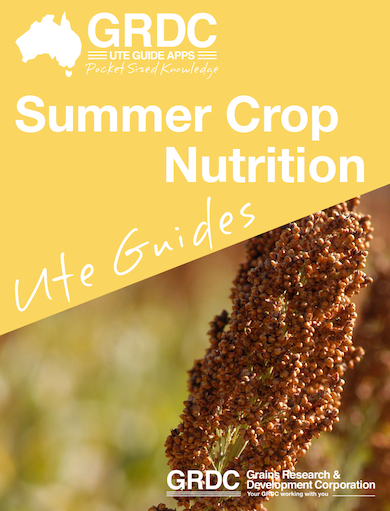Summer Crop Nutrition

Overview
Fertiliser applications are the largest single variable expense for grain growers producing a crop (13% of total costs in 2010-11; ABARES 2011), but nutrition (e.g. nitrogen, phosphorus, potassium, sulphur and micronutrients) is a major determinant of profit. With more frequent use of opportunity cropping, improved farming techniques and crop rotations, and higher yielding varieties, nutrition programs should be reviewed regularly. Common nutrient deficiencies are nitrogen (N), phosphorus (P), potassium (K) and zinc (Zn), while sulfur (S), copper (Cu) and molybdenum (Mo) may be also be lacking in some soil types and growing areas. Molybdenum (Mo) deficiency and manganese (Mn) toxicity can occur in more acidic soils.
Introduction
This Ute Guide is designed to assist in making cost-effective fertiliser decisions. Fertiliser applications are the largest single variable expense for grain growers producing a crop (13% of total costs in 2010-11; ABARES 2011), but nutrition (e.g. nitrogen, phosphorus, potassium, sulphur and micronutrients) is a major determinant of profit.
With more frequent use of opportunity cropping, improved farming techniques and crop rotations, and higher yielding varieties, nutrition programs should be reviewed regularly. Common nutrient deficiencies are nitrogen (N), phosphorus (P), potassium (K) and zinc (Zn), while sulfur (S), copper (Cu) and molybdenum (Mo) may be also be lacking in some soil types and growing areas. Molybdenum (Mo) deficiency and manganese (Mn) toxicity can occur in more acidic soils.
GRDC’s More Profit from Crop Nutrition (MPCN) program aims to improve the return on investment from fertiliser inputs by improving the nutrient use efficiency (NUE) of crops, improving the capacity of soils to supply nutrients, reducing the soils propensity to lose or lock-up nutrients and develop improved fertiliser product formulation and design including the use of potentially valuable low cost and waste inputs.
Purpose of this Ute Guide
This Ute Guide is designed to assist in making cost-effective fertiliser decisions.
To obtain the maximum benefit from investment, fertiliser programs must provide a balance of required nutrients to match yield expectations. There is little point in applying enough N if P or Zn deficiency is limiting yield.
To make better crop nutrition decisions, growers need to consider the use of paddock records, soil and tissue tests and trial test strips. This helps build an understanding of which nutrients the crop removes at a range of yield and protein levels.
The use of paddock grain protein to detect N deficiency is well established for wheat (11.5–12.5%), barley (11–11.5%) and sorghum (9.5–10.5%).
Grain protein lower than these levels is likely to indicate loss of yield due to inadequate N supply. Wheat with a protein level >14% has had its yield limited by lack of moisture, as protein and yield are inversely proportional.
Monitoring of crop growth during the season can assist in identifying factors such as water stress, P or Zn deficiency, disease, pest or other management practices responsible for reducing yield.
How to use this Ute Guide
- Choose the relevant crop.
- Choose the symptom.
- Choose the relevant plant part.
- Trace down the decision tree via symptom to determine the likely nutrient deficiency.
Disclaimer
Any recommendations, suggestions or opinions contained in this publication do not necessarily represent the policy or views of the Grains Research and Development Corporation. No person should act on the basis of the contents of this publication without first obtaining specific, independent professional advice. The Grains Research and Development Corporation will not be liable for any loss, damage, cost or expense incurred or arising by reason of any person using or relying on the information in this publication. The Grains Research and Development Corporation owns the rights to the Ute Guide series.
Copyright
© GRDC 2016
All work contained in this App is subject of copyright owned by or licensed to the Grains Research and Development Corporation. Apart from any use permitted under the Copyright Act 1968, no part of the work may be reproduced in any form or by any process without prior written permission from the Grains Research and Development Corporation. Requests and enquires concerning reproduction and rights should be addressed to:
Manager Publications
Grains Research and Development Corporation
PO Box 5367
Kingston ACT 2604
Australia
Telephone: (02) 6166 4500
Facsimile: (02) 6166 4599
Email: grdc@grdc.com.au
Any requests concerning material that does not originate from the Grains Research and Development Corporation will be forwarded to the appropriate copyright owner.
- See more at: http://www.grdc.com.au/About-Us/Policies/Legal/Copyright
References
Technical Editor: Penny Heuston
Photographs for the Summer Crop Nutrition Ute Guide app supplied by:
FW Smith, CSIRO; Mike Bell, QAAFI; NJ Grundon, QDPI; Jim Laycock, Incitec Pivot Ltd; G Harris; Nikki Seymour, QDAF; T Illing; Mike Cahill, QDPI; Mal Ryley, USQ; W Mills; John Churchett, QDAF; J Barnes; Warwick Easdown, QDPI; Gary Kong; I Martin; P Blamey; G Mills; Andrew Storrie, Agronomo; T Philp; Natalie Moore, NSW DPI; Murray Sharman, QDAF; NSW DPI; Loretta Serafin, NSW DPI; FP Blamey; Matt McRae.
Developed on behalf of GRDC by Seedbed Media and DHM Environmental Software Engineering.
Further information
Loading pathways...
Loading images...
Searching Images
Images that occur in the selected UteGuide appear here. From here you can:
- Use the buttons to filter the displayed images according to key words;
- Hover over a thumbnail image to see it larger;
- Click on the thumbnail image to view the filtered images full screen; and
- Click on the caption to search for all articles that contain that image.